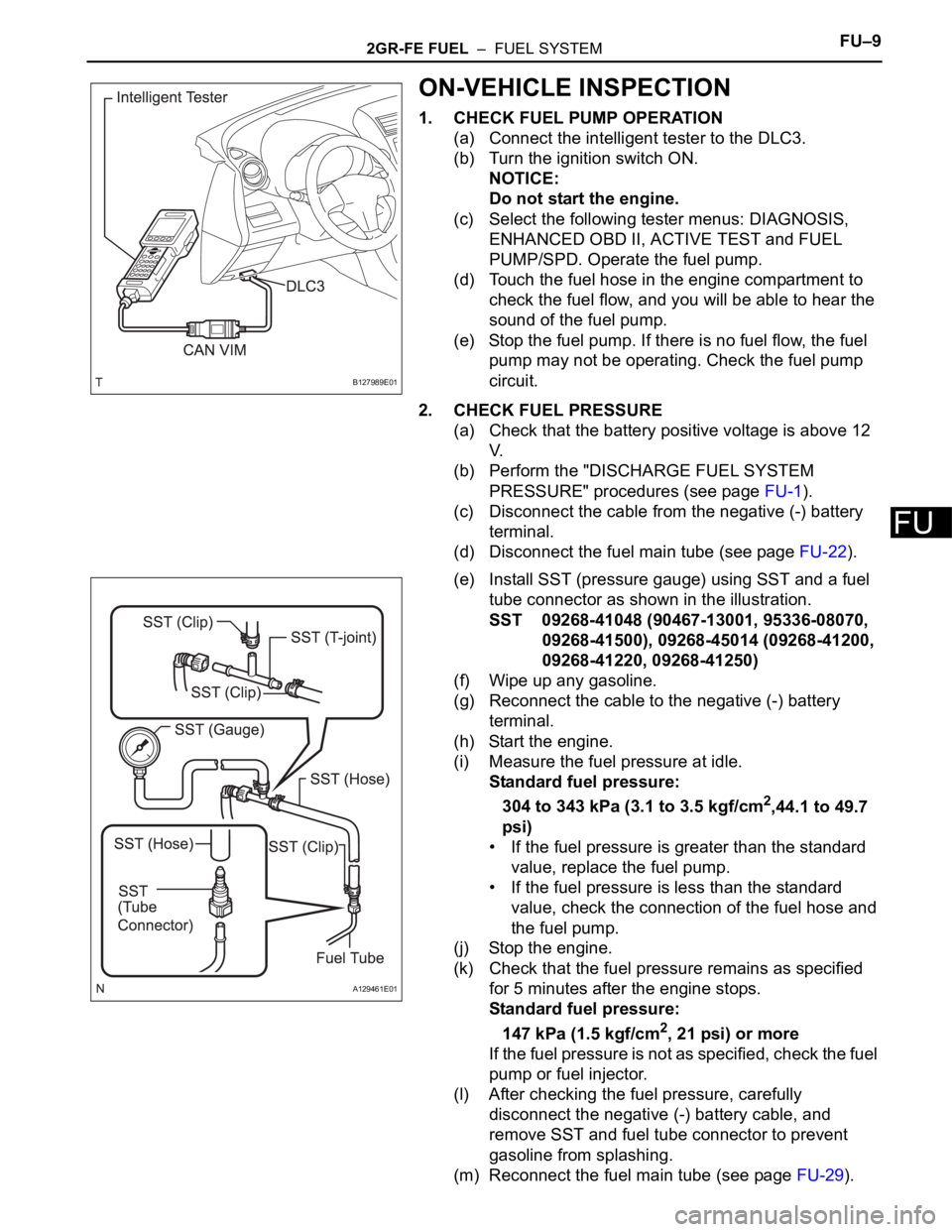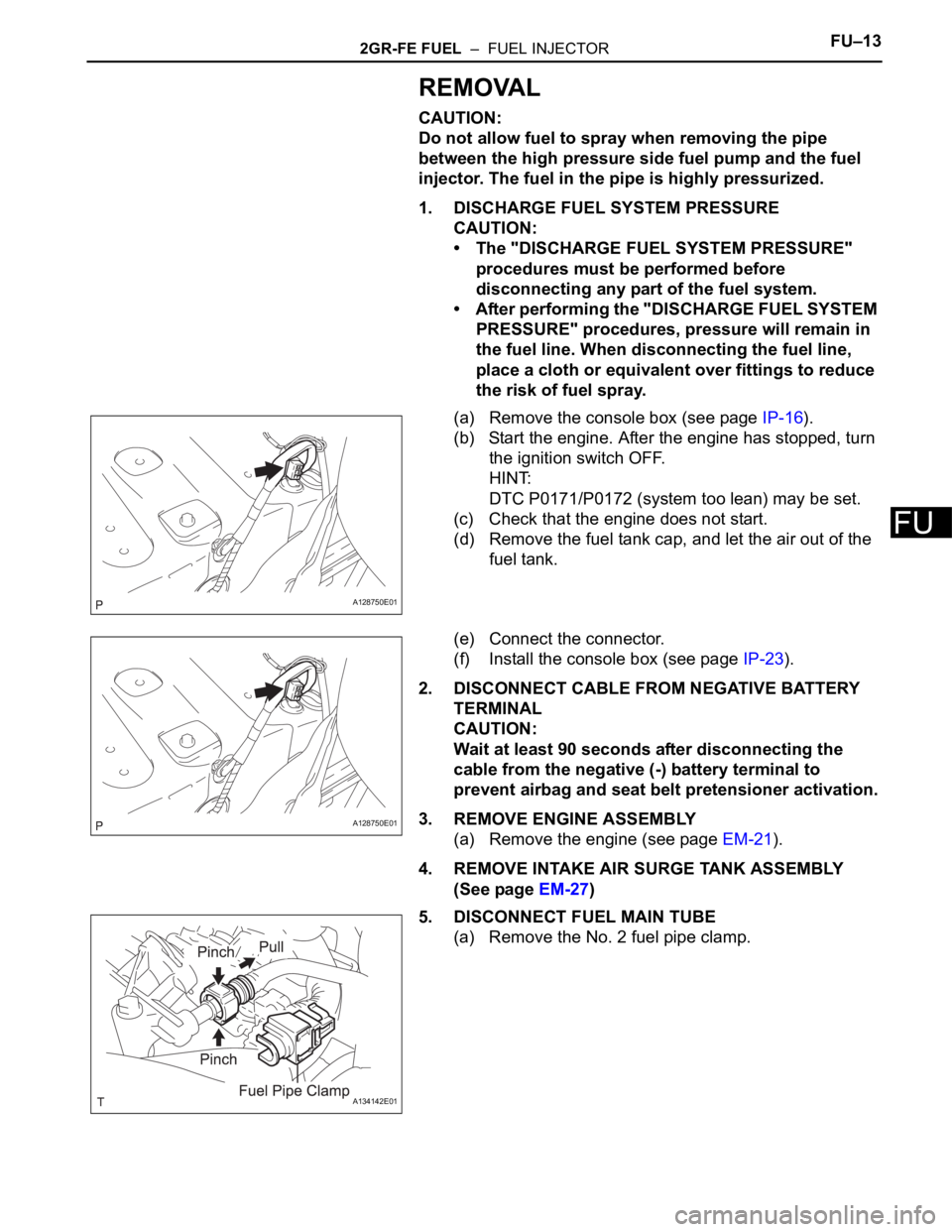2006 TOYOTA RAV4 stop start
[x] Cancel search: stop startPage 801 of 2000

2GR-FE FUEL – FUEL SYSTEMFU–9
FU
ON-VEHICLE INSPECTION
1. CHECK FUEL PUMP OPERATION
(a) Connect the intelligent tester to the DLC3.
(b) Turn the ignition switch ON.
NOTICE:
Do not start the engine.
(c) Select the following tester menus: DIAGNOSIS,
ENHANCED OBD II, ACTIVE TEST and FUEL
PUMP/SPD. Operate the fuel pump.
(d) Touch the fuel hose in the engine compartment to
check the fuel flow, and you will be able to hear the
sound of the fuel pump.
(e) Stop the fuel pump. If there is no fuel flow, the fuel
pump may not be operating. Check the fuel pump
circuit.
2. CHECK FUEL PRESSURE
(a) Check that the battery positive voltage is above 12
V.
(b) Perform the "DISCHARGE FUEL SYSTEM
PRESSURE" procedures (see page FU-1).
(c) Disconnect the cable from the negative (-) battery
terminal.
(d) Disconnect the fuel main tube (see page FU-22).
(e) Install SST (pressure gauge) using SST and a fuel
tube connector as shown in the illustration.
SST 09268-41048 (90467-13001, 95336-08070,
09268-41500), 09268-45014 (09268-41200,
09268-41220, 09268-41250)
(f) Wipe up any gasoline.
(g) Reconnect the cable to the negative (-) battery
terminal.
(h) Start the engine.
(i) Measure the fuel pressure at idle.
Standard fuel pressure:
304 to 343 kPa (3.1 to 3.5 kgf/cm
2,44.1 to 49.7
psi)
• If the fuel pressure is greater than the standard
value, replace the fuel pump.
• If the fuel pressure is less than the standard
value, check the connection of the fuel hose and
the fuel pump.
(j) Stop the engine.
(k) Check that the fuel pressure remains as specified
for 5 minutes after the engine stops.
Standard fuel pressure:
147 kPa (1.5 kgf/cm
2, 21 psi) or more
If the fuel pressure is not as specified, check the fuel
pump or fuel injector.
(l) After checking the fuel pressure, carefully
disconnect the negative (-) battery cable, and
remove SST and fuel tube connector to prevent
gasoline from splashing.
(m) Reconnect the fuel main tube (see page FU-29).
B127989E01
A129461E01
Page 803 of 2000

2GR-FE FUEL – FUEL INJECTORFU–13
FU
REMOVAL
CAUTION:
Do not allow fuel to spray when removing the pipe
between the high pressure side fuel pump and the fuel
injector. The fuel in the pipe is highly pressurized.
1. DISCHARGE FUEL SYSTEM PRESSURE
CAUTION:
• The "DISCHARGE FUEL SYSTEM PRESSURE"
procedures must be performed before
disconnecting any part of the fuel system.
• After performing the "DISCHARGE FUEL SYSTEM
PRESSURE" procedures, pressure will remain in
the fuel line. When disconnecting the fuel line,
place a cloth or equivalent over fittings to reduce
the risk of fuel spray.
(a) Remove the console box (see page IP-16).
(b) Start the engine. After the engine has stopped, turn
the ignition switch OFF.
HINT:
DTC P0171/P0172 (system too lean) may be set.
(c) Check that the engine does not start.
(d) Remove the fuel tank cap, and let the air out of the
fuel tank.
(e) Connect the connector.
(f) Install the console box (see page IP-23).
2. DISCONNECT CABLE FROM NEGATIVE BATTERY
TERMINAL
CAUTION:
Wait at least 90 seconds after disconnecting the
cable from the negative (-) battery terminal to
prevent airbag and seat belt pretensioner activation.
3. REMOVE ENGINE ASSEMBLY
(a) Remove the engine (see page EM-21).
4. REMOVE INTAKE AIR SURGE TANK ASSEMBLY
(See page EM-27)
5. DISCONNECT FUEL MAIN TUBE
(a) Remove the No. 2 fuel pipe clamp.
A128750E01
A128750E01
A134142E01
Page 854 of 2000

CO–62GR-FE COOLING – COOLING FAN SYSTEM
CO
ON-VEHICLE INSPECTION
HINT:
It is normal for the cooling fan to sometimes rotate when the
ignition switch is turned from ACC to ON.
1. CHECK COOLING FAN OPERATION AT LOW
TEMPERATURES (Below 94
C (201F))
(a) Turn the ignition switch ON with the A/C switch OFF.
(b) Check that the cooling fan stops.
If it does not, check the cooling fan relays and
engine coolant temperature sensor, and then check
for disconnection of the connector or wire breaks
between the cooling fan relay and engine coolant
temperature sensor.
(c) Disconnect the engine coolant temperature sensor
connector.
(d) Check that the cooling fan rotates.
If it does not, check the fuses, cooling fan relays,
ECM and cooling fan, and then check for an open
circuit between the cooling fan relay and engine
coolant temperature sensor.
(e) Reconnect the engine coolant temperature sensor
connector.
2. CHECK COOLING FAN OPERATION AT HIGH
TEMPERATURES (Above 96
C (205F))
(a) Start the engine, and then raise the coolant
temperature to above 96
C (205F).
HINT:
Coolant temperature is the value detected by the
engine coolant temperature sensor on the cylinder
head.
(b) Check that the A/C switch is OFF.
A132414
A126963
A132415
Page 960 of 2000

AX–26U140F AUTOMATIC TRANSAXLE – AUTOMATIC TRANSAXLE SYSTEM
AX
PROBLEM SYMPTOMS TABLE
HINT:
• Use the table below to help determine the cause of the
problem symptom. The potential causes of the symptoms
are listed in order of probability in the "Suspected area"
column of the table. Check each symptom by checking the
suspected areas in the order they are listed. Replace parts
as necessary.
• The Matrix Chart is divided into 2 chapters. When
troubleshooting, check Chapter 1 first. If instructions are
given in Chapter 1 to proceed to 2, proceed as instructed.
• If the instruction "Proceed to next circuit inspection shown
in problem symptoms table" is given in the flowchart for
each circuit, proceed to the next suspected area in the
table.
• If the problem still occurs even though there are no
malfunctions in any of the circuits, check the ECM and
replace it if necessary.
CHAPTER 1: ELECTRICAL CIRCUIT MATRIX CHART
HINT:
*: When the circuit is defective, a DTC may be output.
CHAPTER 2: ON-VEHICLE REPAIR AND OFF-VEHICLE REPAIR
Symptom Suspected area See page
No up-shift (1st -> 2nd) ECMIN-37
No up-shift (2nd -> 3rd) ECMIN-37
No up-shift (3rd -> O/D)1. Park/Neutral position switch circuit*AX-39
2. ECMIN-37
No down-shift (O/D -> 3rd) ECMIN-37
No down-shift (3rd -> 2nd) ECMIN-37
No down-shift (2nd -> 1st) ECMIN-37
No lock-up or no lock-up off ECMIN-37
Shift point too high or too low ECMIN-37
Up-shift to O/D from 3rd while shift lever is on 31. Park/Neutral position switch circuit*AX-39
2. ECMIN-37
Up-shift to O/D from 3rd while engine is cold1. Engine coolant temp. sensor circuit*ES-51
2. ECMIN-37
Harsh engagement (N -> D) ECMIN-37
Harsh engagement (lock-up) ECMIN-37
Harsh engagement (any driving position) ECMIN-37
Poor acceleration ECMIN-37
Engine stalls when starting off or stopping ECMIN-37
Malfunction in shifting1. Park/Neutral position switch circuit*AX-39
2. ECMIN-37
Symptom Suspected area See page
Vehicle does not move in all positions other than P and
N1. Manual valveAX-155
2. Primary regulator valveAX-155
3. Front and rear planetary gearAX-155
4. U/D planetary gearAX-155
5. F2 U/D one-way clutchAX-155
6. C1 forward clutchAX-155
7. B3 U/D brakeAX-155
Page 962 of 2000

AX–28U140F AUTOMATIC TRANSAXLE – AUTOMATIC TRANSAXLE SYSTEM
AX
Poor acceleration (all positions)1. Torque converter clutchAX-153
2. U/D planetary gearAX-155
Poor acceleration (O/D)1. C3 U/D clutchAX-155
2. U/D planetary gearAX-155
Large shift shock or engine stalls when starting off or
stoppingTorque converter clutchAX-153
No kick-down Valve body assemblyAX-118 Symptom Suspected area See page
Page 1043 of 2000

U151E AUTOMATIC TRANSAXLE – AUTOMATIC TRANSAXLE SYSTEMAX–27
AX
PROBLEM SYMPTOMS TABLE
HINT:
• Use the table below to help determine the cause of the
problem symptom. The potential causes of the symptoms
are listed in order of probability in the "Suspected area"
column of the table. Check each symptom by checking the
suspected areas in the order they are listed. Replace parts
as necessary.
• The Matrix Chart is divided into 2 chapters. When
troubleshooting, check Chapter 1 first. If instructions are
given in Chapter 1 to proceed to 2, proceed as instructed.
• If the instruction "Proceed to next circuit inspection shown
in problem symptoms table" is given in the flowchart for
each circuit, proceed to the next suspected area in the
table.
• If the problem still occurs even though there are no
malfunctions in any of the circuits, check the ECM and
replace it if necessary.
1. Chapter 1: Electronic Circuit Matrix Chart
Symptom Suspected area See page
No down-shift (a particular gear, from 1st to 4th gear, is
not down-shifted)ECMIN-37
No down-shift (5th -> 4th)1. Transmission control switch (4 <--> D position) circuitAX-44
2. Shift solenoid valve S4 circuit*AX-106
3. ECMIN-37
No up-shift (a particular gear, from 1st to 4th gear, is
not up-shifted)ECMIN-37
No up-shift (4th -> 5th)1. Transmission control switch (4 <--> D position) circuitAX-44
2. Shift solenoid valve S4 circuit*AX-106
3. ECMIN-37
No lock-up1. Stop light switch circuit*AX-62
2. Engine coolant temperature sensor circuit*ES-56
3. ECMIN-37
No lock-up off ECMIN-37
Shift point too high or too low1. Throttle position sensor circuit*ES-56
2. ECMIN-37
Up-shift to 5th from 4th while shift lever on 41. Transmission control switch (4 <--> D position) circuitAX-44
2. ECMIN-37
Up-shift to 5th from 4th while engine is cold1. Engine coolant temperature sensor circuit*ES-56
2. ECMIN-37
Up-shift to 2nd from 1st while shift lever is on L1. Transmission control switch (2 <--> L position) circuit*AX-44
2. ECMIN-37
Harsh engagement (N -> D)1. Shift solenoid valve SL1 circuit*AX-76
2. ECMIN-37
Harsh engagement (lock-up) ECMIN-37
Harsh engagement (any driving position) ECMIN-37
Poor acceleration ECMIN-37
No kick-down ECMIN-37
Engine stalls when starting off or stopping ECMIN-37
Malfunction in shifting1. Park/Neutral position switch circuit*AX-44
2. Transmission control switch (4 <--> D position) circuitAX-44
3. ECMIN-37
Page 1045 of 2000

U151E AUTOMATIC TRANSAXLE – AUTOMATIC TRANSAXLE SYSTEMAX–29
AX
Harsh engagement (4th -> 5th)1. Valve body assemblyAX-142
2. C3 accumulatorAX-180
3. B3 U/D clutchAX-180
Harsh engagement (5th -> 4th)1. Valve body assemblyAX-142
2. B3 accumulatorAX-180
Slip or shudder (forward and reverse: after warm-up)1. Valve body assemblyAX-142
2. Oil strainerAX-142
3. C0 direct and O/D clutchAX-180
4. C1 forward clutchAX-180
5. C3 U/D clutchAX-180
6. B1 2nd and brakeAX-180
7. B3 U/D brakeAX-180
8. F1 No. 1 one-way clutchAX-180
9. F2 U/D one-way clutchAX-180
10. Torque converter clutchAX-178
Slip or shudder (particular position: just after engine
starts)Torque converter clutchAX-178
Slip or shudder (shift lever on R)1. C2 reverse clutchAX-180
2. B2 1st and reverse brakeAX-180
Slip or shudder (1st)1. C1 forward clutchAX-180
2. F1 No. 1 one-way clutchAX-180
3. F2 U/D one-way clutchAX-180
Slip or shudder (2nd) B1 2nd and O/D brakeAX-180
Slip or shudder (3rd) C0 direct and O/D clutchAX-180
Slip or shudder (4th) B1 2nd and O/D brakeAX-180
Slip or shudder (5th) C3 U/D clutchAX-180
Shift position too high or too low Shift solenoid valve SLTAX-120
No engine braking (1st to 4th/shift lever on D) B3 U/D brakeAX-180
No engine braking (1st/shift lever on L)1. Valve body assemblyAX-142
2. B2 1st and reverse brakeAX-180
No engine braking (2nd/shift lever on 2)1. Valve body assemblyAX-142
2. B1 2nd and O/D brakeAX-180
No engine braking (3rd/shift lever on 3) B3 U/D brakeAX-180
No kick-down Valve body assemblyAX-142
Poor acceleration (all positions)1. Shift solenoid valve SLTAX-120
2. Torque converter clutchAX-178
Poor acceleration (5th)1. C3 U/D clutchAX-180
2. U/D planetary gear unitAX-180
Engine stalls when starting off or stopping1. Shift solenoid valve DSLAX-65
2. Torque converter clutchAX-178 Symptom Suspected area See page
Page 1146 of 2000

U151F AUTOMATIC TRANSAXLE – AUTOMATIC TRANSAXLE SYSTEMAX–27
AX
PROBLEM SYMPTOMS TABLE
HINT:
• Use the table below to help determine the cause of the
problem symptom. The potential causes of the symptoms
are listed in order of probability in the "Suspected area"
column of the table. Check each symptom by checking the
suspected areas in the order they are listed. Replace parts
as necessary.
• The Matrix Chart is divided into 2 chapters. When
troubleshooting, check Chapter 1 first. If instructions are
given in Chapter 1 to proceed to 2, proceed as instructed.
• If the instruction "Proceed to next circuit inspection shown
in problem symptoms table" is given in the flowchart for
each circuit, proceed to the next suspected area in the
table.
• If the problem still occurs even though there are no
malfunctions in any of the circuits, check the ECM and
replace it if necessary.
1. Chapter 1: Electronic Circuit Matrix Chart
Symptom Suspected area See page
No down-shift (a particular gear, from 1st to 4th gear, is
not down-shifted)ECMIN-37
No down-shift (5th -> 4th)1. Transmission control switch (4 <--> D position) circuitAX-44
2. Shift solenoid valve S4 circuit*AX-106
3. ECMIN-37
No up-shift (a particular gear, from 1st to 4th gear, is
not up-shifted)ECMIN-37
No up-shift (4th -> 5th)1. Transmission control switch (4 <--> D position) circuitAX-44
2. Shift solenoid valve S4 circuit*AX-106
3. ECMIN-37
No lock-up1. Stop light switch circuit*AX-62
2. Engine coolant temperature sensor circuit*ES-56
3. ECMIN-37
No lock-up off ECMIN-37
Shift point too high or too low1. Throttle position sensor circuit*ES-56
2. ECMIN-37
Up-shift to 5th from 4th while shift lever on 41. Transmission control switch (4 <--> D position) circuitAX-44
2. ECMIN-37
Up-shift to 5th from 4th while engine is cold1. Engine coolant temperature sensor circuit*ES-56
2. ECMIN-37
Up-shift to 2nd from 1st while shift lever is on L1. Transmission control switch (2 <--> L position) circuit*AX-44
2. ECMIN-37
Harsh engagement (N -> D)1. Shift solenoid valve SL1 circuit*AX-76
2. ECMIN-37
Harsh engagement (lock-up) ECMIN-37
Harsh engagement (any driving position) ECMIN-37
Poor acceleration ECMIN-37
No kick-down ECMIN-37
Engine stalls when starting off or stopping ECMIN-37
Malfunction in shifting1. Park/Neutral position switch circuit*AX-44
2. Transmission control switch (4 <--> D position) circuitAX-44
3. ECMIN-37